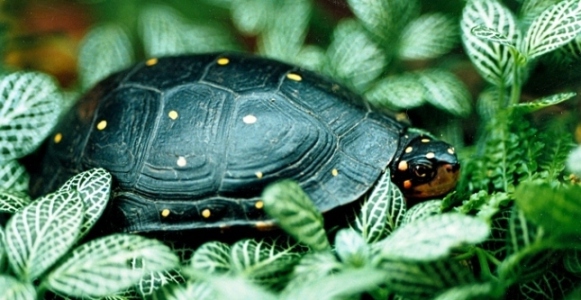
THE TRUTH ABOUT PET TURTLES
By Matt Ellerbeck, January 2008

Turtles have long fascinated and intrigued people. This is probably due in
part to their ancient reptilian appeal and because most people do not hold
the same kind of weariness towards turtles that they might have for snakes
and lizards. It is little wonder then that turtles have become a popular
pet. This popularity however, has had very undesirable affects on turtles.
Many turtles species, including rare and endangered ones, are harvested from
the wild for the pet trade at an alarming rate. This often depletes the wild
population and in extreme cases, it can lead to the local extermination of
certain species. Harvested turtles are often kept in grossly inhumane
conditions as they are shipped around and many of them die before they can
ever be sold off. Those that do survive enter the pet trade heavily infested
with both internal and external parasites. These turtles usually do not live
very long.
Thankfully many of the turtles that are sold in pet shops are bred in
captivity. These turtles do not harm natural the populations. Unfortunately
experts estimate that still too many turtles sold as pets die within one
year. This is due to the inadequate care they receive from their owners.
Most people who buy turtles are unaware of how to provide them with a proper
captive habitat or healthy diet. Turtles are often seen as 'novelty' pets
and their owners usually do not take the time to accurately research about
how to provide them with proper care. Many are also under the assumption
that turtles are low-maintenance pets that require little more then a fish
bowl and some water. The truth is turtles are not low maintenance pets. They
require elaborate setups complete with a source of UVA/UVB light to stay
healthy and an efficient filtration system to keep the water clean.
Many people find that turtles are not suitable pets for them. Their
expensive set-ups and large size (the most common aquatic turtles sold can
grow to be over a foot in length) usually burden their owners. Many of these
pet turtles are then simply given up. Sometimes these turtles are released
into the wild where they usually perish. Those that do survive start
competing with native turtles and upset the balance of the natural
eco-system. For those who are interested in getting a turtle as a pet
consider what you have read. It is also important to first decide in which
kind of turtle species you would like to get and where you will get it.
Remember it is important to only buy captive bred turtles as not to support
the trade in wild caught reptiles. Research must be done to ensure that you
know how to properly care for the turtle, since different species will have
different needs.
The best thing people can do though is to adopt a turtle. This is a good
idea since so many turtles are given up and are in need of a good home. Many
reptile groups and organizations take in turtles temporarily until they can
be adopted out to a good home. Almost all of these are Red-Eared Sliders,
the most common turtles seen in the pet trade. I would urge all readers who
are serious about getting turtles to adopt this species. With proper care
and space, these turtles can be interesting and beautiful pets. It is also
extremely rewarding to give any animal that is in need of a good home just
that.
Matt Ellerbeck lives in Ontario, Canada. You can reach him
thru his email
turtleconservationist@hotmail.com
or visit his
website
Photo Copyright © Zuzana Kukol & REXANO
www.REXANO.org